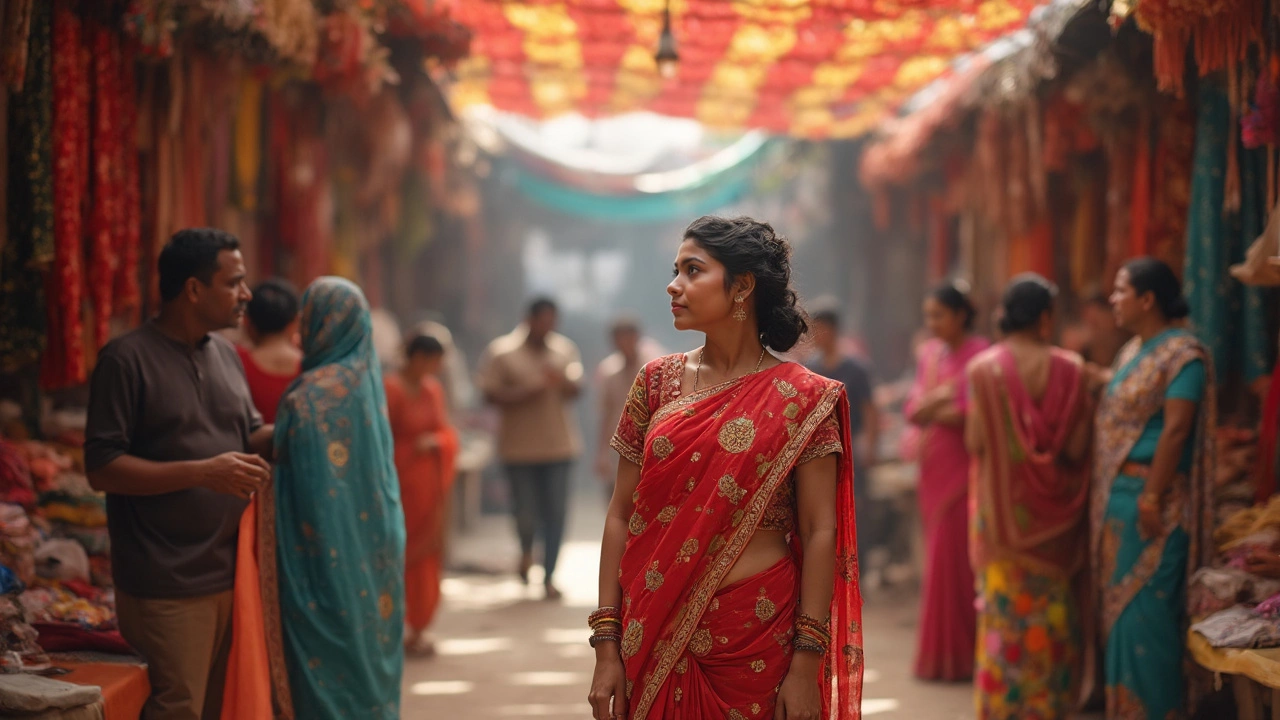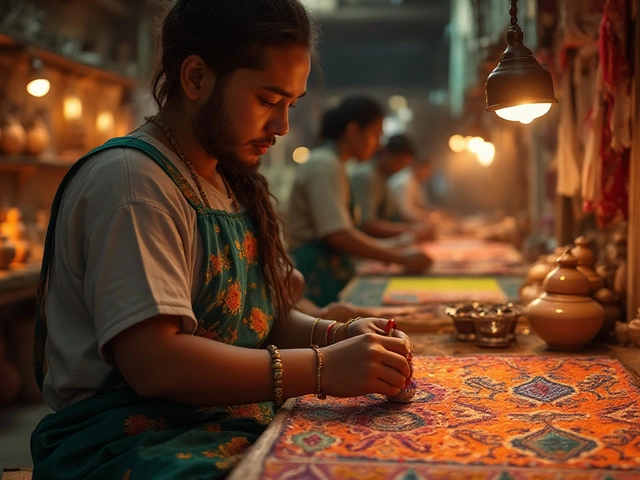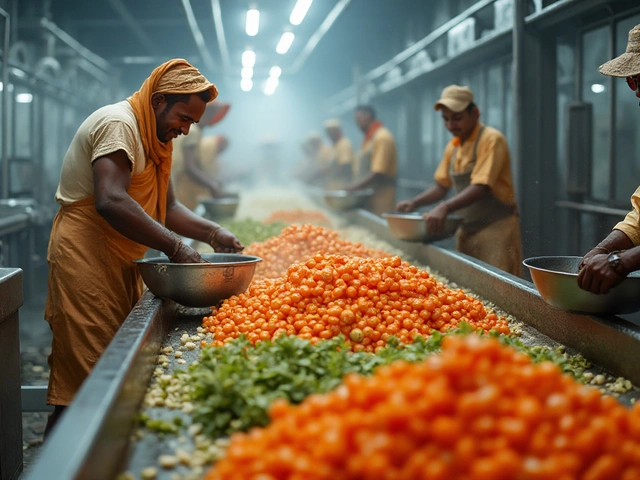Ask one hundred people who the 'queen of textile' is in India, and you’ll probably hear the same answer: Surat. This city’s been at the heart of the Indian textile scene for decades, cranking out everything from polyester saris to glitzy dress materials. If you’ve got a shiny dupatta or a colorful kurta at home, odds are it started its journey in Surat.
But hold on—there’s way more to the story than just one city. The phrase 'queen of textile' doesn’t always mean a place. Sometimes, it’s used for companies or even certain fabrics that have put India on the global map. Knowing who or what owns this crown can help you find better fabrics for your next project or help your business connect with the right suppliers.
Everyone talks about the size of India’s textile industry, but here’s what really matters: Indian mills aren’t just big, they’re flexible. Whether you want fine cotton, wild prints, or embroidered showstoppers, textile manufacturers here can deliver across the board. That’s why you see 'Made in India' tags in stores from New York to Nairobi.
- Unpacking the Queen of Textile Title
- Historic Textile Hubs in India
- Meet the Industry Giants
- Unique Strengths of Indian Textile Makers
- How to Spot Top-Quality Indian Fabrics
Unpacking the Queen of Textile Title
So, who actually gets called the queen of textile in India? Here’s the answer: it’s mostly Surat. This isn't just a nickname for fun—ask anyone in the field and the city’s rep is hard to deny. Surat pumps out nearly 40 million meters of fabric a day. Seriously, that’s enough to make a scarf for almost every person in Australia, and then some.
The city owns about 40% of the entire country’s synthetic textile production, plus it’s a big name in embroidery and fancy fabrics. But where did this title actually come from? Back in the 1990s, as textile hubs like Mumbai shifted focus, Surat went all-in on rapid fabric production and innovation in polyester and man-made fibers. Local manufacturers upgraded their machines and started working day and night to meet demand from within India and abroad.
But it’s not just about geography. Sometimes, 'queen of textile' is used for a standout product or a manufacturer that sets trends. For example, Vardhman Textiles and Arvind Limited are big brands that have major global contracts. They’ve helped move Indian textiles from roadside stalls to fashion runways and global chains.
Check out what makes Surat and these big-time players hold the throne:
- Largest producer of synthetic fabrics in India
- Major contributor to India’s textile exports (almost 28% by volume)
- Massive network of over 450,000 power looms
Here are some quick facts that make Surat’s claim to the crown hard to challenge:
| Factor | Surat's Contribution |
|---|---|
| Daily Fabric Output | 40 million meters |
| India’s Synthetic Textile Share | 40% |
| Number of Power Looms | 450,000+ |
| Employment Provided | ~800,000 people |
The title can shift if another city or manufacturer outpaces Surat, but for now, that crown sits pretty solidly on Surat’s head. If you’re picking suppliers or starting your own label, knowing where the fabric queen reigns helps you tap into the real backbone of Indian textiles.
Historic Textile Hubs in India
If you want to know where the real magic happens in India's textile scene, you’ve got to look at the country’s major textile hubs. These places aren’t just names on a map—they’re the backbone of the industry, some with stories that go back hundreds of years.
Let’s kick off with Surat, which easily grabs the spotlight as the queen of textile. This city leads in synthetic fabrics and dress materials, and its bustling markets pump out millions of meters of fabric every day. Even during tough economic times, Surat keeps the looms running—think of it as the engine room for Indian textiles.
Ahmedabad is known as the “Manchester of the East.” This place has been spinning cotton for over a century. It became famous with the growth of Swadeshi mills back in the 20th century when homegrown cotton challenged imports. The combination of skilled workers and easy access to raw cotton made it one of the most important cotton textile centers in the world.
Ludhiana is your go-to hub for woolen and knitted wear. If you’ve ever bundled up in a soft Indian-made sweater, there’s a good chance it started out here. Ludhiana’s factories are loaded with machines turning out everything from cozy jackets to trendy T-shirts—no wonder it’s called the “Knitwear Capital.”
We can’t forget about Tiruppur down in Tamil Nadu. It might not be as famous as Surat, but Tiruppur is a giant in cotton knitwear exports. Brands across the globe source simple T-shirts and fancy athleisure from here, keeping the local economy buzzing day and night.
Take a quick look at the stats below and you’ll see just how much these hubs matter:
| City | Specialty | Estimated Annual Output (Meters) | Main Products |
|---|---|---|---|
| Surat | Synthetics & Blends | ~30 billion | Saris, Dress Materials |
| Ahmedabad | Cotton Textiles | ~8 billion | Cotton Fabrics, Garments |
| Ludhiana | Woolens & Knits | ~1.1 billion kg yarn ~95% of India’s woolens | Sweaters, T-shirts, Hosiery |
| Tiruppur | Knitwear & Cotton | ~1.5 billion pieces | T-shirts, Kids Wear, Sportswear |
So, if you’re looking to work with Indian manufacturers or want to understand where your favorite fabrics actually come from, keep these hubs in mind. They’re not just big—they’re smart, fast, and connected to what the market wants. That’s what keeps India at the top of the global textile game.
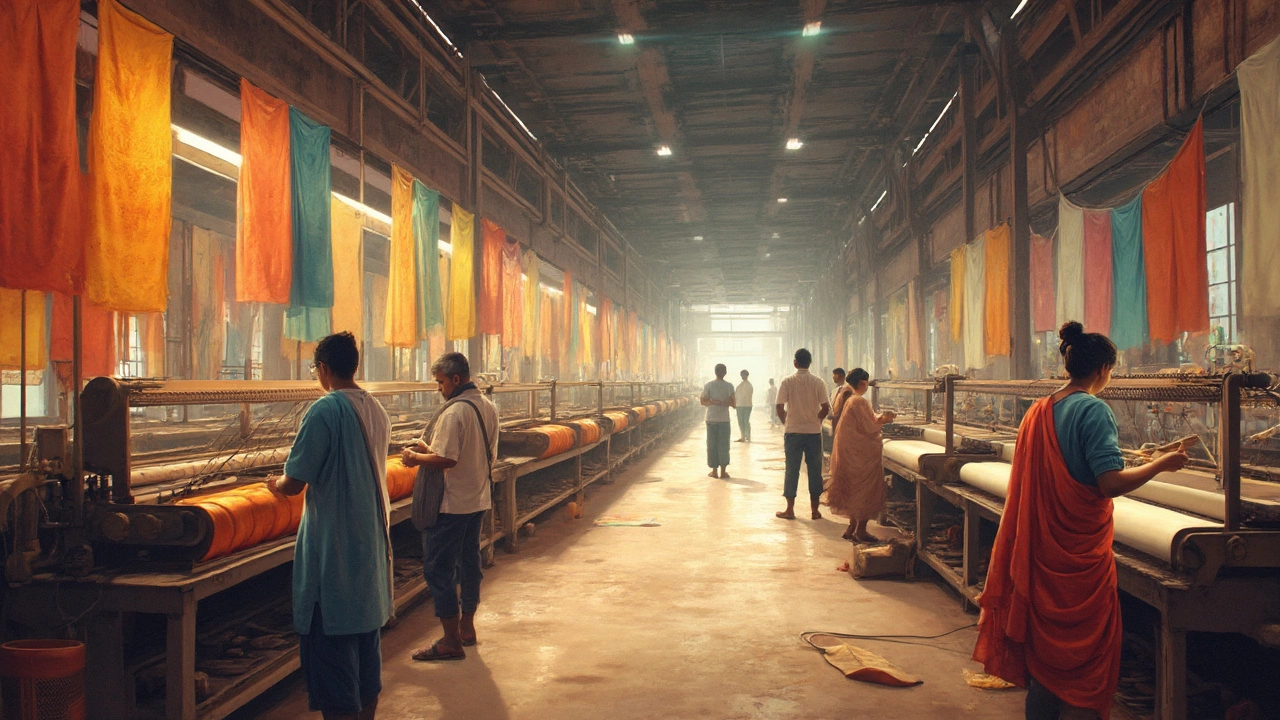
Meet the Industry Giants
If you’ve ever wondered which companies really call the shots in the Indian textile industry, you’ll want to keep reading. Some names dominate the scene, and it’s not just because they’re old—they’ve got reach, innovation, and serious clout in the global market.
Topping the charts is Arvind Limited, based in Ahmedabad. They’re the world’s fourth-largest denim producer—if you own a pair of jeans in India (or even abroad), chances are good Arvind had something to do with it. Besides denim, they handle everything from advanced fabrics to workwear and fashion.
Then there’s Vardhman Textiles from Ludhiana. They’re one of India’s biggest yarn spinners and fabric producers, with over 25 manufacturing plants. They export to more than 75 countries, putting their mark on t-shirts, bed linens, and even uniforms across the globe.
Not to forget Welspun India—famous for towels and home textiles. Flip over a luxury hotel towel or fancy bedsheet, and you might spot their name. They export around 70% of what they make, mostly to the US and Europe.
Got a thing for vibrant saris or dress materials? Alok Industries, headquartered in Mumbai, is worth checking out. They make a ton of polyester and cotton blends, shipping massive volumes in India and overseas. Their products show up everywhere, from local markets to international retail chains.
Let’s break down some quick stats about these giants so you can compare:
| Company | Main Products | Exports To | Special Fact |
|---|---|---|---|
| Arvind Limited | Denim, advanced fabrics | Over 50 countries | World’s 4th largest denim producer |
| Vardhman Textiles | Yarn, fabrics | 75+ countries | 25+ manufacturing plants |
| Welspun India | Towels, bedsheets | US, Europe | Supplies to premium hotels worldwide |
| Alok Industries | Polyester, cotton blends | Global | Massive exports, retail presence |
When you think about the queen of textile in India, these giants aren’t just famous—they set the standards for everyone else. Their products reach millions and shape what’s trendy from Delhi to Dallas.
Unique Strengths of Indian Textile Makers
India’s textile makers have some serious advantages you can’t ignore. For starters, India is known for its crazy variety—cotton, silk, wool, jute, synthetic blends—you name it, they make it. It's not just talk; according to the India Brand Equity Foundation, India is the largest producer of cotton and jute, and the second largest producer of silk in the world. That means buyers can find almost any raw material or finished textile all in one place.
Another big deal is the skilled workforce. Textile crafts in India go back generations. Some families in places like Varanasi or Kanchipuram have been weaving or dyeing fabric for over a hundred years. This kind of hands-on knowledge is hard to replicate anywhere else. It’s why Indian clothing isn’t just about looks—the finishing and details are often next level.
Cost is another power move. Because labor and raw materials are locally available and relatively affordable, Indian manufacturers can keep prices lower than the global average without cutting corners. That’s why even big fashion brands source from here—they get solid work without blowing the budget.
Let’s not forget about innovation. With so many exporters eyeing the global market, Indian factories have stepped up. Nowadays, you’ll see eco-friendly dyes, digital printing, and even recycled textiles getting produced. Many factories hold international certifications like OEKO-TEX or ISO, which helps them win orders from brands abroad.
- Massive raw material variety (cotton, jute, silk, synthetics)
- Generational skills and handmade techniques still in use
- Cost-effective production for both basic and advanced textiles
- Fast adaptation to new tech and global standards
- Strong clusters like Surat and Tiruppur that make supply chains smoother
So, when you see the term queen of textile thrown around, it’s not just hype. It’s the result of these strengths coming together and making India stand out on the world stage.
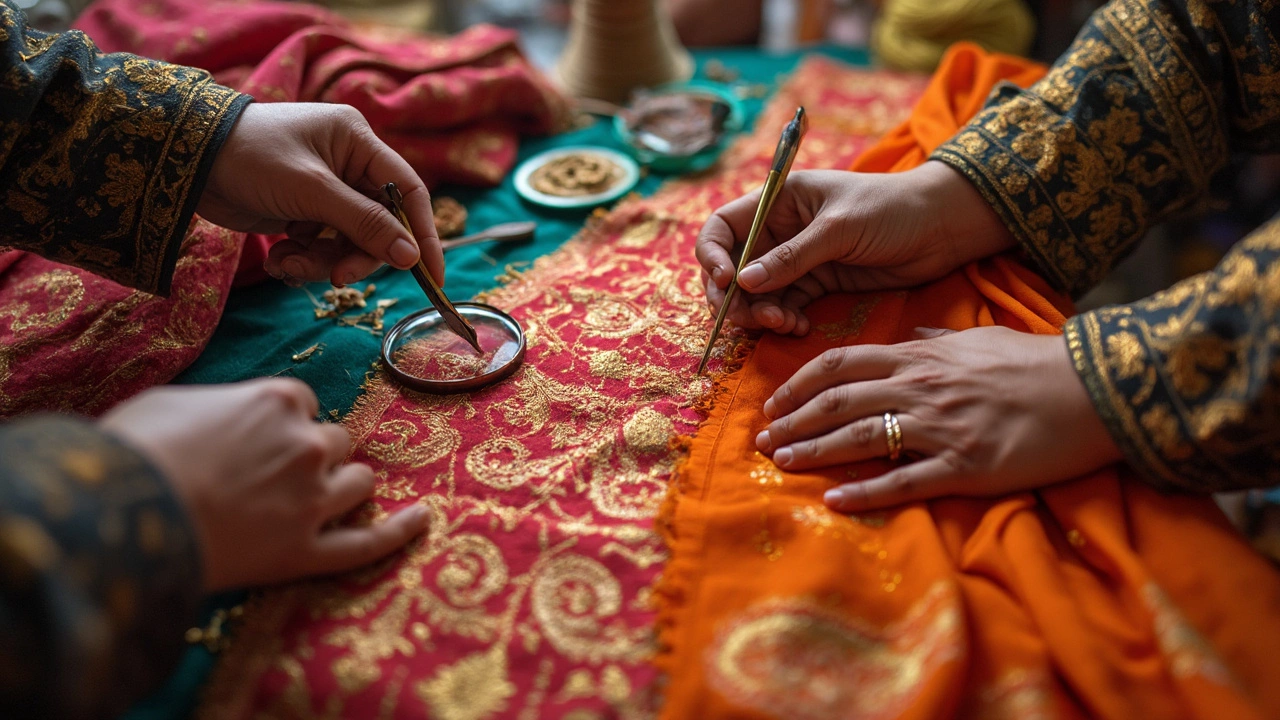
How to Spot Top-Quality Indian Fabrics
If you’re wondering how to sift through the sea of fabrics and come away with something top-tier, here’s what actually matters. Not all saris, cottons, or silks are made equal—there are proven ways to pick out the best.
- Texture tells you a lot. High-quality Indian textiles, like cotton from Tamil Nadu or silk from Varanasi, feel soft but never flimsy. Run your hand over them. Good stuff feels strong, not coarse or scratchy.
- Check the weave. Hold the fabric up to the light. Top-notch material looks even—no big gaps or lots of loose threads. West Bengal’s handloom cottons are famous for their super-tight weaves, and that’s a good standard.
- Color is key. Bright, consistent color that’s the same front and back usually means the dyes are set properly. Uneven or faded patches? Move on.
- Look at finishing. Indian makers who know their stuff don’t leave messy edges or lots of stray threads. That clean finish stands out in everything from block-printed bedsheets in Jaipur to embroidered garments from Lucknow.
- Brand and labels. Top companies like Arvind Mills and Raymond usually include information about fiber count or blend. This helps you check the authenticity, especially when shopping for men’s suiting or fancy saris.
And don’t just take my word for it. As industry expert Rakesh Mehra, Managing Director of Banswara Syntex, puts it:
“You can spot quality Indian textiles with your senses—touch for strength, look for evenness, and check colors for depth. Proven suppliers will always show you samples and answer questions about how and where the fabric’s made.”
If you want to buy real-deal Indian textiles, visit trusted shops or order directly from certified exporters. Real textile manufacturers India won’t hide details on raw materials or treatments. And if something seems too cheap for the quality promised, think twice. The best fabric always feels and looks right in your hands.
